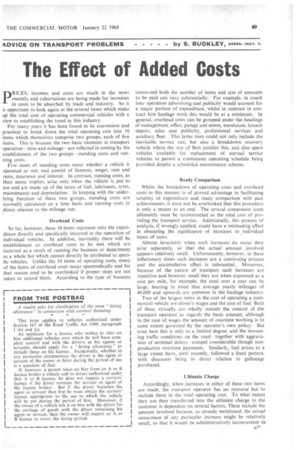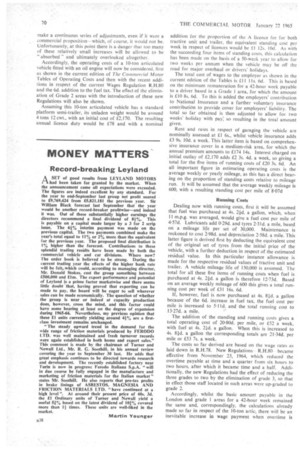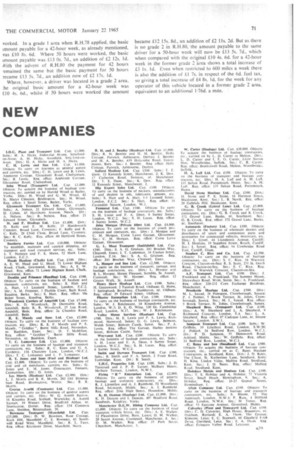The Effect of Added Costs
Page 71

Page 72

Page 73

If you've noticed an error in this article please click here to report it so we can fix it.
PRICES, incomes and costs are much in the news recently and exhortations are being made for increases in costs to be absorbed by trade and industry. So it is opportune to look again at the several item i which make up the total cost of operating commercial vehicles with a view to establishing the trend in this industry.
For many years it has been found to be convenient and practical to break down the total operating cost into 10 items which themselves comprise two groups, each of five items. This is because the two basic elements in transport operation—time and mileage—are reflected in costing by the establishment of the two groups —standing costs and running costs.
Five items of standing costs occur whether a vehicle is operated or not, and consist of licences, wages, rent and rates, insurance and interest. In contrast, running costs, as their name implies, arise only when the vehicle is put to use and are made up of the items of fuel, lubricants, tyres, maintenance and depreciation. In keeping with the underlying function of these two groups, standing costs are normally calculated on a time basis and running costs in direct relation to the mileage run.
Overhead Costs So far, however, these 10 items represent only the expenditure directly and specifically incurred in the operation of individual vehicles. In addition, inevitably there will be establishment or overhead costs to be met which are incurred as a result of running the business or department as a whole but which cannot directly be attributed to specific vehicles. Unlike the 10 items of operating costs, manY of the items of overhead costs occur spasmodically and for that reason tend to be overlooked if proper steps are not taken to record them. According to the type of business
concerned both the number of items and size of amounts to be paid can vary substantially. For example, in coach tour operation advertising and publicity would account for a major portion of expenditure, whilst in contrast in contract hire haulage work this would be at a minimum. In general, overhead costs can be grouped under the headings of management, office, garage and stores, warehouse, branch depots, sales and publicity, professional services and auxiliary fleet. This latter item could not only include the inevitable service van, but also a breakdown recovery vehicle where the size of fleet justifies this, and also spare vehicles available for replacement of normal service vehicles to permit a continuous operating schedule being provided despite a scheduled maintenance scheme.
Ready Comparison
Whilst the breakdown of operating costs and overhead costs in this manner is of proved advantage in facilitating scrutiny of expenditure and ready comparison with past achievements, it must not be overlooked that this procedure is only a means to an end. The several component costs ultimately must be reconstructed as the total cost of providing the transport service. Additionally, this process of analysis, if wrongly applied, could have a misleading effect in obscuring the significance of increases to ,individual items of costs.
Almost invariably when such increases do occur they arise separately, so that the actual amount involved appears relatively small. Unfortunately, however, in these inflationary times such increases are a continuing process and the accumulative effect is substantial. Moreover, because of the nature of transport such increases are repetitive and however small they are when expressed as a cost per mile, for example, the total over a year can be large, bearing in mind that average yearly mileages of 40,000 and upwards are common in the haulage industry.
Two of the largest items in the cost of operating a commercial vehicle are driver's wages and the -cost of fuel. Both of these virtually are wholly outside the control of the transport operator as regards the basic amount, although in the case of wages the amount of overtime working is to some extent governed by the operator's own policy. But even here this is only to a limited degree, and the worsening traffic conditions on the road—together with aggravation of terminal delays .compel considerable though nonproductive overtime payments. Similarly, fuel prices to a large extent have, until recently, followed a fixed pattern, with discounts being in direct relation to gallonage Purchased.
Ultimate Charge Accordingly, when increases in either of these two items are made, the transport operator has no recourse but to include these in the total operating cost. To what extent they are then transferred into the ultimate charge to the customer is dependent on several factors. These include the amount involved because, as already mentioned, the actual occurrence of any particular increase might be relatively small, so that it would be administratively inconvenient to make a continuous series of adjustments, even if it were a commercial proposition--which, of course. it would not be. Unfortunately, at this point there is a danger that too many of these relatively small increases will be allowed to be " absorbed " and ultimately overlooked altogether.
Accordingly, the operating costs of a 10-ton articulated vehicle fitted with an oil engine will now be considered, first as shown in the current edition of The Commercial Motor Tables of Operating Costs and then with the recent additions in respect of the current Wages Regulation R.H.80 and the 6d. addition to the fuel tax. The effect of the elimination of Grade 2 areas with the introduction of these new Regulations will also be shown.
Assuming this 10-ton articulated vehicle has a standard platform semi-trailer, its unladen weight would be around 4 tons 12 cwt., with an initial cost of £2,170. The resulting annual licence duty would be £78 and with a nominal addition for the proportion of the A licence fee for both tractive unit and trailer, the equivalent standing cost per week in respect of licences would be £1 12s. 10d. As with the succeeding four items of standing costs, this calculation has been made on the basis of a 50-week year to allow for two weeks per annum when the vehicle may be off the road for major overhaul or drivers' holidays.
The total cost of wages to the employer as shown in the current edition of the Tables is £11 I Is. 6d. This is based on the minimum remuneration for a 42-hour week payable to a driver based in a Grade 1 area, for which the amount is £10 8s. 6d. To this is added the employers' contribution to National Insurance and a further voluntary insurance contributiOn to provide cover for employers' liability. The total so far obtained is then adjusted to allow for two gwieveekns' holiday with pay; so resulting in the total amount Rent and rates in respect of garaging the vehicle are nominally assessed at £1 6s., whilst vehicle insurance adds £3 9s. 10d. a week. This latter item is based on comprehensive insurance cover in a medium-risk area, for which the annual premium amounts to £174 14s. Interest charged on initial outlay of £2,170 adds £2 3s. 4d. a week, so giving a total for the five items of running costs of £20 3s. 6d. An all important figure in estimating operating costs is the average weekly or yearly mileage, as this has a direct bearing on the proportion of standing costs relative to mileage run. It will be assumed that the average weekly mileage is 600, with a resulting standing cost per mile of 8.07d
Running Costs
Dealing now with running costs, first it will be assumed that fuel was purchased at 4s, 21d. a gallon, which, when 11 m.p.g. was averaged, would give a fuel cost per mile of 4-57d. Lubricants add 0-29d. and tyres 2.31d. a mile, based on a mileage life per set of 30,000. Maintenance is reckoned to cost 2-98d. and depreciation 2.58d. a mile. This latter figure is derived first by deducting the equivalent cost of the original set of tyres from the initial price of the vehicle, with a further deduction in respect of the estimated residual value. In this particular instance allowance is made for the respective residual values of tractive unit and trailer. A vehicle mileage life of 150,000 is assumed. The total for all these five items of running costs when fuel is purchased at 4s. 21d. a gallon is therefore 12.73d. Based on an average weekly mileage of 600 this gives a total running cost per week of £31 16s. 6d.
if, however, fuel is now purchased at 4s. 81d. a gallon because of the 6d. increase in fuel tax, the fuel cost per mile is increased to 5-11d. and the total running cost to 13.27d. a mile.
The addition of the standing and running costs gives a total operating cost of 20-80d. per mile, or £52 a week, with fuel at 4s. 21d. a gallon. When this is increased to 4s. 81d. a gallon the corresponding totals are 21.34d. per mile or £53 7s. a week.
The costs so far derived are based on the wage rates as laid down in R.H.78. New Regulations-R.H.80 became effective from November 23, 1964, which reduced the overtime payable at time and a quarter from six hours to two hours, after which it became time and a half. Additionally, the new Regulations had the effect of reducing the three grades to two by the elimination of grade 3, so that in effect those staff located in such areas were up-graded to grade 2.
Accordingly, whilst the basic amount payable in the London and grade 1 areas for a 42-hour week remained the same and, correspondingly, the calculations already made so far in respect of the 10-ton artic, there will be an inevitable increase in wage payment when overtime is
vorked. In a grade 1 area when R.H.78 applied, the basic 'mount payable for a 42-hour week, as already mentioned, as £10 8s. 6d. Where 50 hours were worked, the basic 'mount payable was £13 Os. 7d., an addition of £2 12s. Id. Nith the advent of R.H.80 the payment for 42 hours -emained the same but the basic payment for 50 hours )ecame £13 5s. 7d., an addnion now of £2 17s. Id.
Where, however, a driver was located in a grade 2 area, :he original basic amount for a 42-hour week was EIO 4s. 6d., whilst if 50 hours were worked the amount became £12 15s. 8d., an addition of £2 us. 2d. But as there is no grade 2 in R.H.80;the amount payable to the same driver for a 50-hour week will now be £13 5s. 7d„ which when compared with the original £10 4s. 6d. for a 42-hour week in the former grade 2 area shows a total increase of £3 Is. Id. Even when restricted to 600 miles a week there is also the addition of £1 7s. in respect of the 6d. fuel tax, so giving a total increase of £4 8s. Id. for the week for any operator of this vehicle located in a former grade 2 area, equivalent to an additional 1.76d. a mile,




















































































































